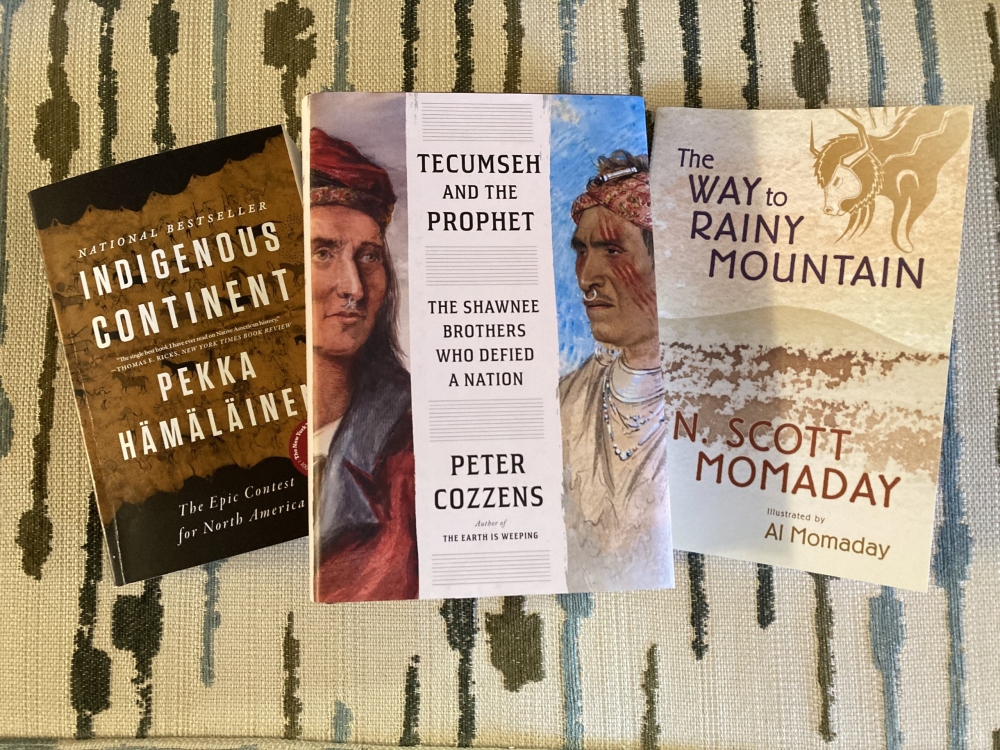Though I mourn the closed-minded fragmentation currently dividing my nation, I am grateful for the debate over how to tell the story of America. Grateful not for the tone, or the belittling and bullying, but for an opportunity to reflect on the story I believe and tell. I began with assuming mine is at best incomplete (I am finite), to greater or lesser extent wrong (sinners taught me the story I grew up with), and unjust to some of my neighbors (it’s difficult to tell one story for such a gloriously pluralistic populace in such a large nation). To help me learn I have intentionally included some books in my reading that can be portals into aspects of America’s history that I know too little about. Here are three I recommend.
Indigenous Continent by Pekka Hämäläinen.
Pekka Hämäläinen, a Finnish scholar, is Rhodes Professor of American History at Oxford University. In Indigenous Continent, he paints with a broad brush, telling the story of North America from deep in prehistory through to the 19th century. And he tells it in a way I’ve never heard before. Hämäläinen tells it from the perspective of the Native American tribes who lived here for centuries—for millennia in fact—before northern European settlers showed up in ships on the eastern coast and claimed the land for themselves. I need to hear this telling of the American story because in many ways it turns the story I was told on its head.
Indigenous Continent is well researched, a story told in lively prose that sweeps us along, more like a novel than a serious work of history by an academic. Hämäläinen knows the history, culture, values, and beliefs of the various Native American tribes, and helps us see things from their perspective.
Hämäläinen is aware that his approach is not what the descendants of northern European colonialists have likely heard before. And, truth be told, I suspect many of them may likely prefer not to hear it at all. But we need to hear it.
Indigenous Continent… offers a new account of American history by challenging the notion that colonial expansion was inevitable and that colonialism defined the continent, as well as the experiences of those living on it. Stepping outside of such outdated assumptions, this book reveals a world that remained overwhelmingly Indigenous well into the nineteenth century. It argues that rather than a “colonial America,” we should speak of an Indigenous America that was only slowly and unevenly becoming colonial. By 1776, various European colonial powers together claimed nearly all of the continent for themselves, but Indigenous peoples and powers controlled it. The maps in modern textbooks that paint much of early North America with neat, color-coded blocks confuse outlandish imperial claims for actual holdings. The history of the overwhelming and persisting Indigenous power recounted here remains largely unknown, and it is the biggest blind spot in common understandings of the American past. [p. ix-x]
Telling such a big story in Indigenous Continent means there are myriad details I could not keep track of, or (especially at my age) remember accurately. But I enjoyed reading it a great deal and was rocked by how much my version of the story of America needs revision.
Tecumseh & the Prophet by Peter Cozzens
Peter Cozzens, a member of the American Foreign Service, is the author of numerous books on the American Civil and Indian Wars. In Tecumseh & the Prophet he takes one episode from Hämäläinen’s broader history—the fascinating story of two Native American brothers, Shawnees, who tried, through oratory and mysticism, to unite the tribes to stop the encroachment of white settlers flooding across the Appalachians. They failed, but as Cozzens explains, their story needs to be known.
Though they did not create the concept of pan-Indianism, the Shawnee brothers’ achievements were prodigious. Before the Shawnee brothers, there had been prophetic movements and intertribal alliances against the French, British, and Americans in their turn. The Shawnee brothers themselves acknowledged the debt they owed the Ottawa war chief Pontiac and the Delaware mystic Neolin, who together had opposed British bullying of the Eastern Woodland tribes in the 1760s. The ad hoc confederacies of Pontiac and Neolin, and later of Chiefs Blue Jacket and Little Turtle had also blunted the white wave, but these were relatively localized movements. It was the Shawnee brothers who would emerge as truly transformative figures, able to unite adherents from more than a dozen tribes in confronting both the spiritual and physical menace the young American Republic posed to the Indian way of life. Their goal of a grand Indian alliance provides a window into the larger story of the turbulent early days of the United States, when American settlers spilled over the Appalachians and killed or intimidated Indians with a contemptuous disregard for treaty and law in their haste to exploit lands recently won from the British in the War of Independence. The violent treatment of the Indians and rampant lawlessness in the Old Northwest presaged the excesses of the American West half a century later and is the bloody bridge to that era, the story of which must be told if we are to appreciate the heritage of our nation’s heartland.
Tecumseh and Tenskwatawa stepped onto the stage just as the young American Republic flexed its expansionist muscles. Indisputably, Tecumseh and Tenskwatawa were the most significant siblings in American Indian history. Giving Indians their due, it is only fair to conclude that the Shawnee brothers also were among the most influential siblings in the annals of America. [p. xiv-xv]
This is a well told story of courage, Native American mysticism, and leadership during turbulent days, with two men passionately pursuing a vision to save their land and people, even at the cost of their lives. It is also the story of failure. Their failure to achieve that vision, and the abject failure of white Americans to follow their own stated ideal, that “all men are created equal.”
The Way to Rainy Mountain by N. Scott Momaday
Scott Momaday, a Pulitzer Prize winner, is a Kiowa novelist, poet, college professor, and essayist. He is able to tell powerful stories in just a few words.
Except for pages given to lovely, metaphorical black and white illustrations by Momaday’s father, each two-page spread in the book follows a simple pattern. Or, as Momaday describes it, provides three voices. The left page is a Kiowa myth, the voice of Momaday’s father who passed them on to his son as they had been passed to him. The next voice, in a short paragraph on the right side, is a piece of history that resonates in the Kiowa mind with the ancient myth. And finally, a final paragraph, a bit of memoir, in which Momaday tells of his upbringing within a Kiowa family and culture.
One morning my father and I walked in Medicine Park, on the edge of small herd of buffalo. It was late in the spring, and many of the cows had newborn calves. Nearby a calf lay in the tall grass; it was red-orange in color, delicately beautiful with new life. We approached, but suddenly the cow was there in our way, her great dark head low and fearful-looking. Then she came at us, and we turned and ran as hard as we could. She gave up after a short run, and I think we had not been in any real danger But the spring morning was deep and beautiful and our hearts were beating fast and we knew just then what it was to be alive. [p 55.]
The Way to Rainy Mountain is a tender book, full of affection, memory, longing, prayer, love, and a healthy immersion in family, community, land, and creation. Momaday brings us into the heart, an hearts, of his Kiowa family and world in a way seldom depicted in the media.
Books recommended:
Indigenous Continent: The Epic Contest for North America by Pekka Hämäläinen (New York, NY: Liveright Publishing; 2022); 463 pages + notes + index.
Tecumseh & the Prophet: The Shawnee Brothers Who Defied a Nation by Peter Cozzens (New York, NY: Alfred A. Knopf; 2020); 435 pages + appendix + Notes + Bibliography + index.
The Way to Rainy Mountain by N. Scott Momaday, Illustrated by Al Momaday (Albuquerque, NM: University of New Mexico Press; 1969) 89 pages.
Photo credit: By the author with his iPhone.



